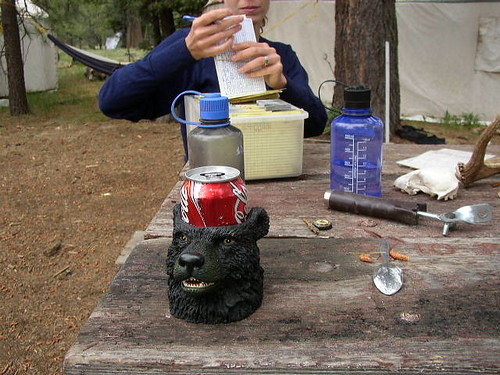A. checked in from Flagstaff yesterday, the town closest to Bird Camp and where the crew gets “shore leave” every nine days or so for laundry, showers, square meals and the like. (The research project rents a block of motel rooms where everyone stays.) On top of the usual fun, this break also saw the crew members who will be trapping small mammals fitted for the respirators they will wear to protect themselves from hanta virus. When A. called, she was just waiting for everyone to meet up for the return drive to camp.
So far, 14 out of the eventual 24 field staff have reported. Next week, A.’s predecessor, who has been helping get the camp set up and giving A. some last pointers for the season, will depart, allowing A. to finally assume the mantle of camp commandant all on her own. Meanwhile, the crew members that have arrived are being trained in bird identification, nest location, field navigation and the other skills necessary for the project’s work. Training has been hampered a little in the last few days by extremely high winds, making any bird calls inaudible. It’s been cold, too, in the 20s each morning but warming as the sun gets higher in the sky. At those temperatures, you need to keep your water bottle in your sleeping bag to keep it from freezing. This is a cold snap, though; it was warmer when A. and the rest of the crew first arrived, and A. hopes it will warm up again soon.
Though the crew is not yet fully staffed, research has commenced. So far, the crew has found about 20 nests out of the 800-1,000-nest goal for the season. Most of the birds are still in the building and laying phase, though, so there hasn’t been any nestling or egg-mass measuring yet. “I’m hoping to to start probing my first eggs later this week,” A. says, referring to the process whereby a needle-like instrument is inserted into an egg – without harming it – to collect various health data.
Among the things A. isn’t hoping to do is shoot squirrels, although it’s a distinct possibility. For the first time this year, the project is eliminating as many predators as possible from some of its enclosed areas plots in order to isolate other possible causes of “nest failure.” They can’t do anything to prevent predation by other birds, but they can try to get rid of as many small mammals as possible. This is being done mainly through trapping, “but squirrels don’t trap well,” A. says, which means that someone has to shoot them, instead. Right now, A.’s predecessor is taking care of this with the camp rifle, a .22 caliber varmint piece, and there’s a chance that all of the necessary squirrel-shooting will be done before she leaves next week. If not, though, it may be A., lying on her belly, waiting for a squirrel to get careless (maybe by being third on a match?), squeezing, squeezing, bang. Hard to imagine, I know. She’s having a little trouble with the idea herself.

